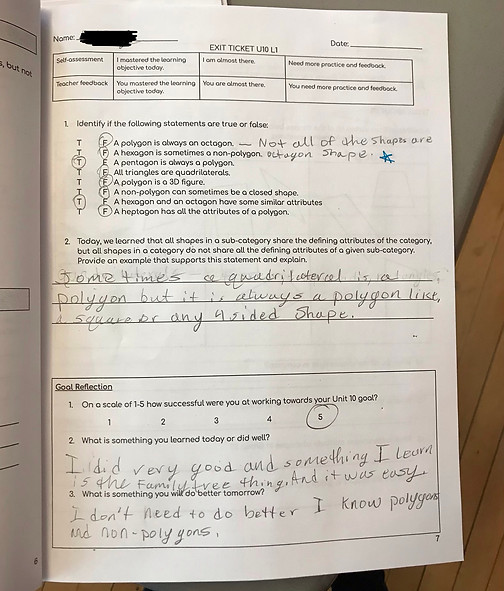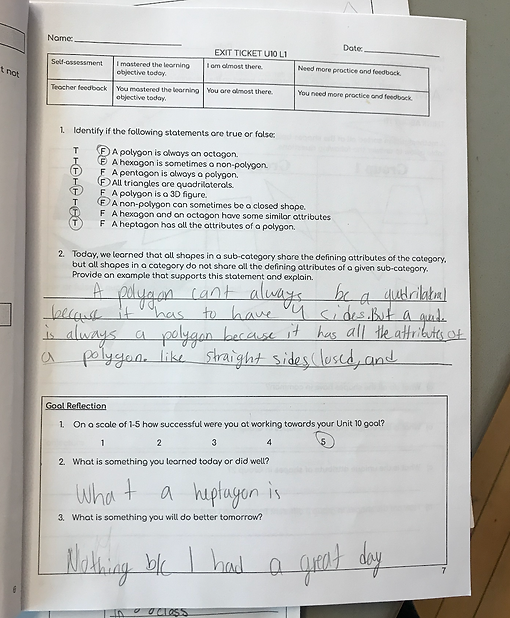Lesson Planning
Introduction
Achievement First provides daily lesson plans to teachers. The purpose of this is to maintain a high bar of rigor and consistency between our classrooms. However, it is important these lessons be altered to meet and engage my students. From the lesson plan, I am able to gain insight the lesson objective, the connection to the standards, and assessment. While the lesson plan provides scripting and questioning to guide teachers through the Think About It and Interaction with New Material, there are a number of additional problems for students to practice. While modifying the Think About It and Interaction with New Material to challenge my students appropriately, I need to select various level problems to make practice time as efficient as possible. While identifying these questions, I anticipate student misconceptions and created a planned interruption. This process allows my lesson planning process to be efficient and effective.
Achievement First Unit 10 Lesson 1 Plan
Below is the first lesson in Unit 10. In this lesson, students differentiate between non-polygons and polygons. This is their first attempt at developing a hierarchy. While reviewing the provided lesson plan below, I noticed a lack of rigor. Providing students with an example of polygons and non-polygons alongside their names did not require the critical thinking skills I strive to develop with my students.
While I decided to re-write a portion of the lesson, the details provided in the lesson overview allowed me to understand how I could blend Lesson 1 and Lesson 2 to make a more rigorous lesson. The number of problems provided was used as a resource bank for my own lesson.
Tyer Unit 10 Lesson 1 Plan
As seen above, the lesson plan provided by Achievement First offered a plethora of information about the lesson connect to overall learning goals, directions on instruction, and numerous problem types for students to be able to grapple with. Understanding the learning of my students and the need to increase the bar of rigor, I rewrote the plan to blend Lesson 1 and Lesson 2.
In my re-written students are able to interact with more real-world images and develop their own hierarchy. Given that the hierarchy is the foundation of this unit, I believe it is important to have students develop this from the beginning. As the unit processes, we will consistently return to this to build out our understanding of 2-dimensional figures.
Additionally, I compared each problem to the standard and identified a number of problems that were high rigor and standards-aligned. Once these problems were identified they were categorized based on difficulty. This was intentional to support all learners to meet rigorous learning goals.
Tyer Unit 10 Lesson 1 Reflection
After teaching Unit 10 Lesson 1, I was able to identify a number of areas of growth. During my first lesson, students were overwhelmed by the family tree I provided. As I moved into the second and third class, I adjusted the family tree to only contain three generations so students could relate to parents and child as sub-categories of grandparents. After this modification, students were able to understand the sharing of attributes between different shapes. However, after looking at their exit ticket it was clear there was a lack of clarity around the word sub-category. An example of this is seen below when a student references attributes as genes. This demonstrates an inability to define and use the word sub-category to describe the relationship between two shapes. In order to address this misconception, I reviewed the term sub-category in Unit 10 Lesson 2 and asked students to use the word within their justifications.


The image to the left is another piece of evidence that demonstrates a misunderstanding in hierarchical thinking. In this piece of work, the student contradicts herself by saying "Sometimes a quadrilateral is a polygon but it is always a polygon". This lack of thorough understanding is from insufficient execution on hierarchical thinking. As we go through the rest of the unit, I will ensure students understand the content map on the front of their packet for conceptual understanding. Evidence of this can be found in the section on Unit Planning.
The image to the right is another piece of evidence from this lesson. This student illustrates the lesson's focus on defining attributes by stating "A quadrilateral is always a polygon because it has all the attributes of a polygon like straight sides [and] closed". While this student did not use the vocabulary term of sub-category they demonstrate a conceptual understanding of hierarchical thinking by naming attributes. After evaluating all three pieces of work, it is clear to see there is a need to address future plans to encourage student's use with unit vocabulary.

Conclusion
It is my belief as an educator that lesson planning is only as effective as its responsiveness. Although it may be seen easy to be given lesson plans by Achievement First, it not enough. As a teacher, I must internalize the lesson in depth and evaluate its alignment to standards, assessments, and most importantly my students. Each classroom has a different vibe. It is critical these are accounted for a modified to in order to keep students engaged and learning. By utilizing daily data and responding to my students' various needs, I plan daily lesson plans that will guide them to rigorous content concepts daily. This experience is invaluable in student learning and success.